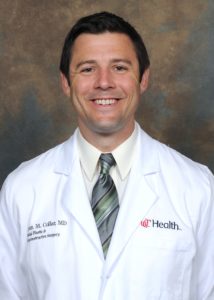Predictive Models Promising in Reducing Risk of 30-day Patient Readmission in Head and Neck Cancer Patients
A new study shows promise in identifying head and neck cancer patients who are at risk for unplanned 30-day hospital readmission. Ryan M. Collar, MD, MBA, assistant professor, director of quality, otolaryngology head and neck surgery, facial plastic and reconstructive surgery, at the University of Cincinnati (UC) Medical Center, is the lead author. The project came out of his work at the Massachusetts Institute of Technology (MIT) Sloan School of Management’s Analytics Edge program in which opportunities arose to leverage modern data analytics in healthcare. He described the genesis of the study as two-fold: “to improve patient outcomes and to prepare for the value-based health care delivery environment.”
In many specialties, unplanned hospital readmission within 30 days of discharge is a significant factor in health care costs. For head and neck cancer surgery, the readmission rate ranges from 7% to 16%, and the average cost per readmission is greater than $35,000.1-4 Dr. Collar and his co-authors developed predictive analytic models that were aimed at achieving quality improvement and cost reduction in identifying patients at greater risk of readmission. The goal, Dr. Collar says, is to “create an algorithm that will sufficiently predict which patients are at high risk for readmission at the time of discharge so that we can systematically modify our workflows on the spot,” ultimately driving quality of care at a lower cost through smart resource allocation.
The study comprised a retrospective review of patients hospitalized for surgery for head and neck cancer at UC Medical Center and prospective surgical quality improvement program data (originally championed by Dr. Keith Casper) to develop models to predict 30-day readmission. The models used logistic regression, classification and regression tree (CART) analysis, and Random Forests. The admissions data were split randomly into two sets: one training set to build predictive models, and a test set in which the models were tested for accuracy, positive predictive value, and sensitivity. Further, the best performing models were then put into practice with actual patient discharges to assess predictive power.
According to study findings, readmission within 30 days of discharge was 19% for the study population. The best performing model was created using Random Forests which is a machine learning modality. Key attributes in the model included fistula formation, body mass index less than 18.5, and adjusted gross income (AGI) greater than $90,000 as positive correlates of readmission, and oral cavity primary as a negative correlate of readmission. When applied to a cohort of consecutive head and neck oncology patient discharges (82 discharges), the logistic regression model performed favorably, with an encouraging 75% positive predictive value.
Dr. Collar described AGI as an unexpected finding, suggesting that socioeconomic factors may be more influential in health care decision making than physicians might expect. “We’re always thinking about physiological factors,” he says, but social factors are also key drivers of behavior and ultimately impact healthcare outcomes.
Based on the study, Dr. Collar and his co-authors are now examining “new care pathways” before or after discharge, with high-risk patients receiving closer attention before leaving the hospital, more frequent follow-up in-clinic, and more focused home health care and outpatient counseling.
According to Dr. Collar, next steps might involve studying this model across other specialties, especially in those that have greater numbers of patients. He emphasized the importance of collecting appropriate information in a structured clinical data set common to specialties and institutions.
References
1. Dziegielewski PT, Boyce B, Manning A, et al. Predictors and costs of readmissions at an academic head and neck surgery service. Head Neck. 2016;38(suppl 1):E502-510.
2. Offodile AC 2nd, Pathak A, Wagner J, Orgill DP, Guo L. Prevalence and patient-level risk factors for 30-day readmissions following free tissue transfer for head and neck cancer. JAMA Otolaryngol Head Neck Surg. 2015;141:783-789.
3. Graboyes EM, Liou TN, Kallogjeri D, Nussenbaum B, Diaz JA. Risk factors for unplanned hospital readmission in otolaryngology patients. Otolaryngol Head Neck Surg. 2013;149:562-571.
4. Shellenberger TD, Madero-Visbal R, Weber RS. Quality indicators in head and neck operations: a comparison with published benchmarks. Arch Otolaryngol Head Neck Surg. 2011;137:1086-1093.
 Ryan M. Collar, MD, MBA
Ryan M. Collar, MD, MBA
Assistant Professor, Director of Quality
Otolaryngology Head and Neck Surgery
Facial Plastic and Reconstructive Surgery
Phone: (513) 475-8444
Email: collarrm@uc.edu
Connect with Dr. Collar on Doximity
Leave a reply →
